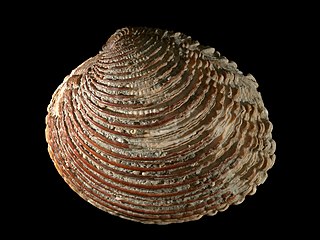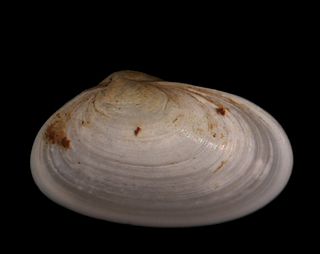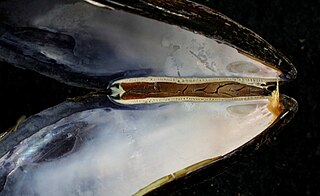
Bivalvia or bivalves, in previous centuries referred to as the Lamellibranchiata and Pelecypoda, is a class of aquatic molluscs that have laterally compressed soft bodies enclosed by a calcified exoskeleton consisting of a hinged pair of half-shells known as valves. As a group, bivalves have no head and lack some typical molluscan organs such as the radula and the odontophore. Their gills have evolved into ctenidia, specialised organs for feeding and breathing.

The Veneridae or venerids, common name: Venus clams, are a very large family of minute to large, saltwater clams, marine bivalve molluscs. Over 500 living species of venerid bivalves are known, most of which are edible, and many of which are exploited as food sources.
Laternulidae, common name lantern clams, is a family of saltwater clams, marine bivalve molluscs in the order Anomalodesmata.

A bivalve shell is the enveloping exoskeleton or shell of a bivalve mollusc, composed of two hinged halves or valves. The two half-shells, called the "right valve" and "left valve", are joined by a ligament and usually articulate with one another using structures known as "teeth" which are situated along the hinge line. In many bivalve shells, the two valves are symmetrical along the hinge line — when truly symmetrical, such an animal is said to be equivalved; if the valves vary from each other in size or shape, inequivalved. If symmetrical front-to-back, the valves are said to be equilateral, and are otherwise considered inequilateral.

Petricolaria pholadiformis, common names false angelwing, or false angel wing (US), and American piddock (UK), is a species of saltwater clam, a marine bivalve mollusk in the family Veneridae, the Venus clams.

Fabulina fabula, the bean-like tellin, is a species of marine bivalve mollusc in the family Tellinidae. It is found off the coasts of northwest Europe, where it lives buried in sandy sediments.

Tellimya ferruginosa is a species of small marine bivalve mollusc in the family Lasaeidae. It is found on the eastern side of the Atlantic Ocean.
Phaxas pellucidus, the transparent razor shell, is a species of marine bivalve mollusc in the family Pharidae. It is found buried in the seabed in coastal waters of northwest Europe, often in great numbers.

Venerupis is a genus of marine bivalve molluscs in the family Veneridae commonly known as carpet shells. The valves are robust and rhomboidal with the umbones turned-in and nearer the anterior end. The posterior end is wedge-shaped and the internal margins of the valves are smooth. There are 3 or 4 cardinal teeth on each valve. The foot is large and the siphons are of medium length and united except at the very tip.

Thracia convexa is a bivalve mollusc in the family Thraciidae.

Mulinia lateralis, the dwarf surf clam or coot clam, is a species of small saltwater clam, a bivalve mollusc in the family Mactridae. It occurs in the western Atlantic Ocean and the Caribbean Sea.

A hinge ligament is a crucial part of the anatomical structure of a bivalve shell, i.e. the shell of a bivalve mollusk. The shell of a bivalve has two valves and these are joined by the ligament at the dorsal edge of the shell. The ligament is made of a strong, flexible and elastic, fibrous, proteinaceous material which is usually pale brown, dark brown or black in color.

Solemya elarraichensis is a species of marine bivalve mollusc in the family Solemyidae. It is endemic to the deep-water mud volcano slopes in the Gulf of Cadiz in the eastern Atlantic Ocean.

Thracia is a genus of bivalve mollusc in the family Thraciidae.
Thracia corbuloidea is a bivalve mollusc in the family Thraciidae.
Thracia pubescens is a bivalve mollusc in the family Thraciidae.
Cyathodonta plicata is a bivalve mollusc in the family Thraciidae.

Polititapes aureus is a species of bivalve belonging to the family Veneridae.

Lucinella divaricata, the divaricate lucine, is a small marine bivalve mollusc of the family Lucinidae found in the north eastern Atlantic and the Mediterranean. Its fossils are known from Cenozoic deposits all over Europe. Chemoautotrophic bacteria in their gills enable them to survive well in substrates rich in hydrogen sulfide.

Chamelea striatula, the striped venus clam, is a marine bivalve mollusc of the family Veneridae which inhabits the northern shores of Europe.















